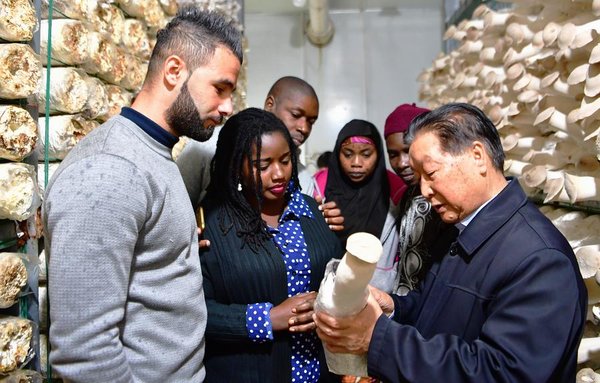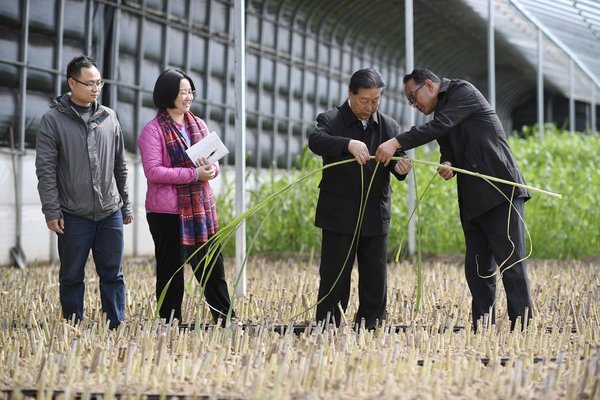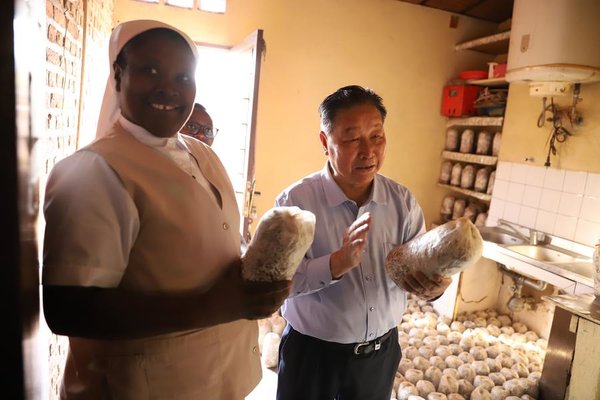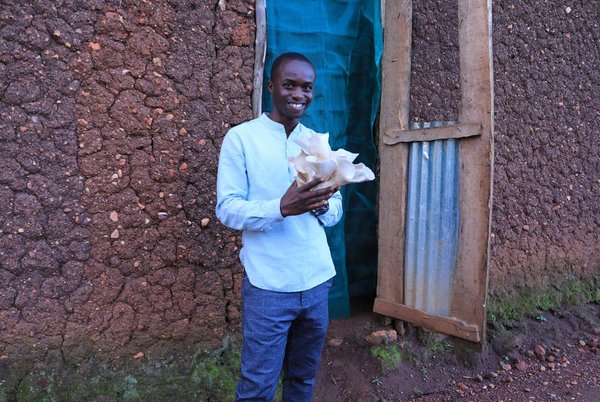 |
| Lin Zhanxi (1st from right) of Fujian Agriculture and Forestry University introduces Juncao technology to African students in Fuzhou, southeast China’s Fujian Province, Nov. 2, 2018. (Xinhua/Wei Peiquan) |
To date, over 14,000 people have been trained in Juncao technology in almost 350 international workshops. Introductory materials are now available in 18 languages for worldwide use.
“The test results were very promising,” said Professor Lin Zhanxi. “Juncao is the grass of happiness, a gift from China to everyone.”
KIGALI/FUZHOU, Aug. 27 (Xinhua) — It was pleasantly warm and dry in Rwanda in early August, and young farmers in the southern province celebrated a bountiful harvest. In their hands was not corn or rice, but mushrooms cultivated using technology transferred from a faraway land to this “land of a thousand hills” in Africa.
Also attending the ceremony was Professor Lin Zhanxi. The octogenarian scientist has led a research team on Juncao technology in China’s southeastern Fujian province since the 1980s. The hybrid grass technology allows mushrooms to grow on grass-based substrates instead of felled trees, offering a solution to the threat to forests posed by the mushroom industry.
The plant’s name means “mushroom” and “grass” in Chinese. Its versatility is an important feature, as it allows the cultivation of edible mushrooms, the provision of livestock feed and the fight against desertification.
Thanks to the active and visionary promotion of Chinese President Xi Jinping, Juncao is flourishing in China and beyond, improving living conditions and promoting sustainable development in developing countries in the Asia-Pacific region, Africa and Latin America.
A way out of poverty
Before becoming known as the “Father of Juncao,” Lin grew up in the poor rural mountains of Fujian. His personal experiences with poverty deeply shaped his commitment to Juncao technology.
After decades of work, Lin and his team have succeeded in selecting and breeding a high-yielding, drought- and salt-resistant herbaceous plant that can be used as a wood substitute for growing edible and medicinal mushrooms.
At the WTO’s ninth Aid-for-Trade Global Review Conference in Geneva in June, Lin spoke about how Juncao technology began its global journey. It was in 1992 when Lin first introduced Juncao to great acclaim at an international inventors’ exhibition, also in Geneva. There in Switzerland, Lin received many calls wanting to learn more about the technology.
Lin recalled Xi’s passion for using scientific and technological means to combat poverty.
In 1997, Xi, then deputy party secretary of the Fujian Provincial Committee of the Communist Party of China, included Juncao technology in the province’s poverty alleviation efforts in the northwestern Ningxia Hui Autonomous Region. When Lin received the assignment, he immediately traveled to Xihaigu, a poverty-stricken region in Ningxia, with his team and grass and mushroom seeds.
Today, Juncao technology is used in 31 provinces across China and has made a significant contribution to ending poverty and revitalizing rural areas.
 |
| Lin Zhanxi (2nd from right) exchanges Juncao cultivation knowledge with farmers in the mining city of Yinchuan, northwest China’s Ningxia Hui Autonomous Region, March 29, 2021. (Xinhua/Wang Peng) |
With Xi’s support, a pilot project to introduce Juncao technology was launched in Papua New Guinea in 2000; it was one of the first applications of Juncao technology abroad.
Driven by their dedication and pioneering spirit, Lin and other Chinese researchers have since introduced the technology to 106 countries and regions around the world.
With the goal of ending poverty around the world, Chinese scientists have used Juncao technology in some difficult environments. In the eastern highlands of Papua New Guinea, they witnessed tribes still practicing slash-and-burn agriculture; in Rwanda, families toiled in muddy fields without livestock or tractors, using only hoes; and in the Central African Republic, they observed the devastating effects of post-conflict famine.
During all these years, Lin has been the victim of armed robbery, malaria, altitude sickness, and long stays in remote outposts without electricity or water. Extreme poverty in developing countries has only strengthened Lin’s commitment to Juncao.
“We go to the poorest areas with the sincere intention of helping people,” Lin explained.
A plant of prosperity
Agnes Ayinkamiye is the first coordinator of the Juncao project in Rwanda.
“I was particularly pleased that we helped people. The project was well received and we trained many people, especially women’s cooperatives and youth groups,” she said. “I really enjoyed the work and was excited to be able to work with experts.”
“Juncao technology allows people to make money and is very popular,” Ayinkamiye added.
Lin noted that around 4,000 Rwandan households have benefited from the technology and that some of them have seen their income double or even triple over the years.
 |
| Lin Zhanxi (right), a professor at China’s Fujian University of Agriculture and Forestry, visits a mushroom cultivation hall in Kigali, Rwanda, on Aug. 2, 2024. (Xinhua/Ji Li) |
“Juncao technology is affordable… This technology is being applied in a way that makes it affordable for people at a very local level, which I think is the main advantage,” said Earle Courtenay Rattray, Chief of Staff to the United Nations Secretary-General.
Seruwaia Kabukabu, an entrepreneur in Serea village in Fiji’s Naitasiri Province, is one of the women trained at the Juncao Demonstration Centre in Nadi, Fiji’s third largest city.
“After the training, each of us received free bags of mushroom substrate from the center. Under the guidance of technical experts, we started harvesting and selling mushrooms within 7 to 10 days, earning money for our family,” said Kabukabu.
With the proceeds from the Juncao project, she was able to improve her family’s standard of living by purchasing essential appliances, building a concrete toilet and bathroom, and even contributing to a clean water project in her community.
“Fiji faces numerous challenges ranging from geographical isolation to vulnerability to natural disasters due to climate change, which hampers agricultural and sustainable development as well as food security,” said Kabukabu.
Over the last decade, over 2,400 people in Fiji have been trained in Juncao technology. The area under Juncao cultivation in Fiji is over 2,000 hectares.
“Easy to learn and effective to implement,” Lin said, stressing that Juncao technology should lower its technical application threshold abroad, “so that even the poorest farmers can participate.”
To date, over 14,000 people have been trained in Juncao technology in almost 350 international workshops. Introductory materials are now available in 18 languages for worldwide use.
Never-ending experiment
In addition to mushroom cultivation, Juncao Technology has continued to innovate and expand its production to feed and fertilizer.
Since Tahiya Massawe, a farmer in Bumbwi Sudi, Tanzania, started using juncao as livestock feed, he has seen improvements in milk density and nutritional value, as well as increased milk production.
“It also saved me money,” she told Xinhua, “because by using this grass I save the money I previously spent on other feed.”
Farmers are propagating Juncao and using it in their fields. Many testimonials show that farmers have accepted the technology simply because the forage is rich, says Makame Kitwana, director of planning, policy and research at the Tanzanian Ministry of Agriculture.
“It has been scientifically proven in various ways that the protein and carbon content are high, so cattle eating Juncao grass are happier than other grasses,” he said.
 |
| Nyambo Obed shows the cultivated mushrooms in his workshop near Muhanga in Southern Province, Rwanda, April 6, 2024. (Xinhua/Dong Jianghui) |
Juncao can also help with ecological management.
Soil erosion is a serious problem in countries like Rwanda. Rwandan officials feared that if the soil problem could not be solved, Rwanda would run out of land to cultivate. Lin always kept their concerns in the back of her mind.
He still remembers the experimental data from Rwanda, which he visited over ten years ago. One day, 51.4 millimetres of rain fell in two and a half hours. All of the rain was captured by the giant grass (Juncao), which was very effective at storing water and holding the soil in place.
In February, Lin also worked in Fiji on applying Juncao technology to saline soil management, with the aim of finding additional solutions to combat climate change in developing countries, including Pacific Island countries.
“The test results were very promising,” Lin said. “Juncao is the grass of happiness, a gift from China to everyone.”
(Source: Xinhua)
Editor: Wang Shasha
